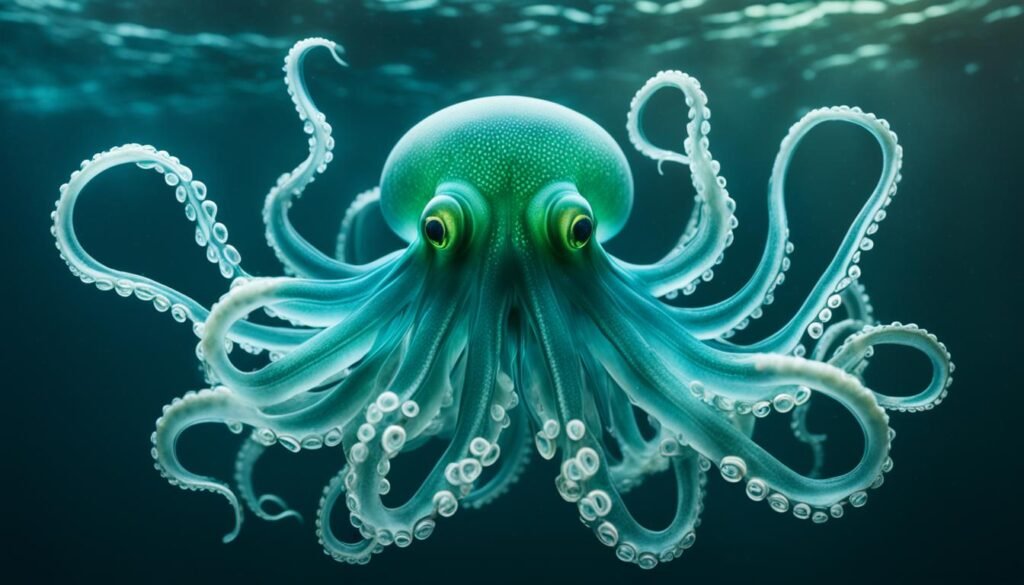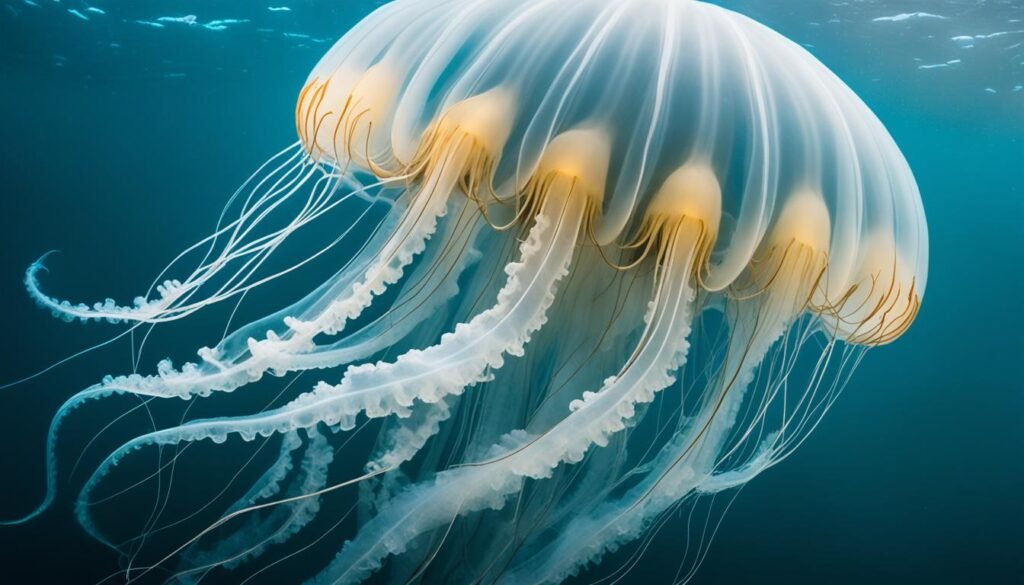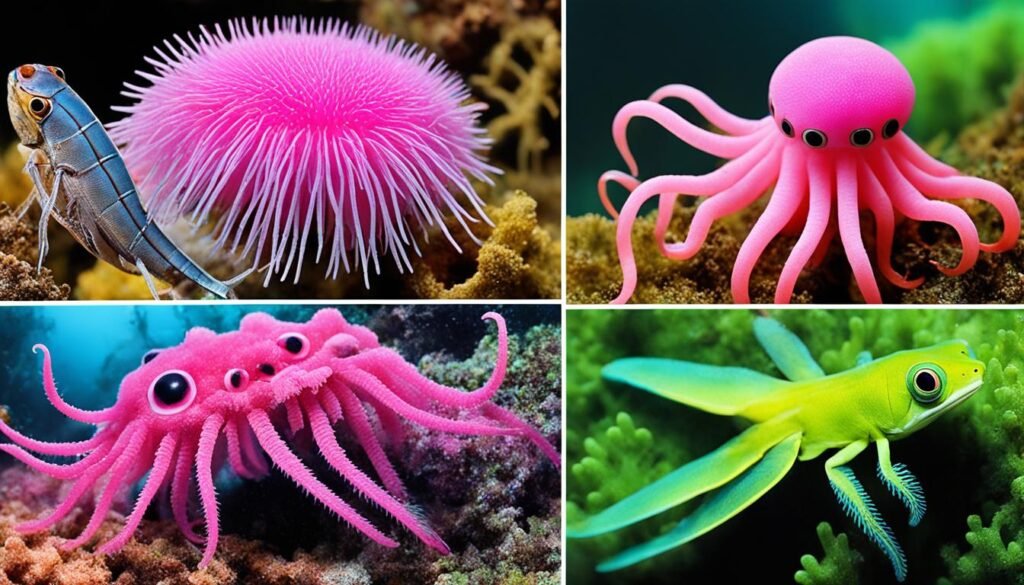Prepare to be amazed as we embark on a journey through the extraordinary animal kingdom. From bizarre creatures to unusual wildlife, we will unveil the top 10 strangest animals in the world. Buckle up and get ready to dive into a world of weird animal facts, peculiar wildlife discoveries, and quirky creature sightings that will challenge your beliefs and ignite your curiosity.
Have you ever wondered what unique animal species roam our planet? Do you think you know all there is to know about the animal kingdom? Think again. Get ready to be astounded as we uncover some of the most incredible animal species you never knew existed. From majestic yet mysterious creatures to odd animal behavior that defies explanation, prepare to question everything you thought you knew about the natural world.
So, are you ready to explore the pit of the unknown? Are you prepared to delve deep into the world of mysterious animals that roam our planet? Let’s begin our journey into the extraordinary, where the bizarre becomes beautiful and reality surpasses imagination.
Key Takeaways:
- Discover the top 10 strangest animals in the world.
- Challenge your beliefs about the animal kingdom.
- Explore unique animal species and their peculiar behaviors.
- Unveil extraordinary wildlife discoveries.
- Embark on a journey into the unknown and encounter mysterious animals.
Bizarre Blood-Red Jellyfish of Deep Sea Mysteries
Deep within the depths of the ocean, a world filled with astounding creatures and mysteries awaits. Among these fascinating inhabitants are the blood-red jellyfish, an enigmatic species with a striking appearance that captivates scientists and researchers alike.
Discovery of Possible New Jellyfish Species
In recent years, scientists have made a remarkable discovery in the deep sea – a potential new species of jellyfish. This finding has sparked excitement and intrigue within the scientific community, shedding light on the diverse and mysterious marine ecosystem that exists below the surface.
The blood-red jellyfish, with its vibrant crimson hue, stands out amidst the dark and mysterious depths of the ocean. Its unique characteristics and behaviors have led experts to question whether it belongs to a previously undocumented species.
Adaptations in Deep-Sea Coloration
One of the most intriguing aspects of the blood-red jellyfish is its deep-sea coloration. While many jellyfish species are transparent or translucent, these mysterious creatures possess a striking red coloration that sets them apart.
This deep-red hue is believed to play a crucial role in their survival in the dark depths of the ocean. It acts as a form of camouflage, allowing the jellyfish to blend into the dimly lit environment and evade potential predators. This adaptation showcases the remarkable ways in which organisms have evolved to thrive in challenging conditions.
Moreover, the blood-red coloration of these jellyfish is thought to be a result of the presence of unique pigments within their bodies. Further research is ongoing to unravel the secrets behind these vivid hues and their significance in the deep-sea ecosystem.
The peculiar adaptations of the blood-red jellyfish highlight the incredible diversity and resilience of life in the deep sea. As scientists continue to explore and unravel the mysteries of the ocean depths, these enigmatic creatures provide valuable insights into the complex web of life that exists beneath the waves.
Unveiling the Elusive Glass Octopus
The deep sea is home to many fascinating creatures, but few are as mysterious and elusive as the glass octopus. This enigmatic cephalopod has intrigued researchers for years, with its translucent body and ethereal appearance. Its delicate nature and ability to blend seamlessly with its surroundings make it a true marvel of the deep sea.

Studying the glass octopus presents unique challenges for scientists. Its elusive nature and deep-sea habitat make it difficult to observe and track. Unlike other species of octopus that can change color and shape to camouflage themselves, the glass octopus relies on its transparent body to remain hidden from predators. This adaptation, while fascinating, also makes it elusive and difficult to study.
Recent deep-sea expeditions and advancements in technology have shed some light on the behavior and ecology of the glass octopus. Researchers have observed these elusive creatures in their natural habitat, revealing their graceful movement and intriguing behaviors. They have also discovered that glass octopuses have a unique reproductive strategy, with females using long, flexible stalks to attach their eggs to the seafloor.
The deep-sea discovery of the glass octopus serves as a reminder of the vast and mysterious world that lies beneath the ocean’s surface. These incredible creatures are a testament to the rich biodiversity and adaptability of marine life. By unraveling the secrets of the elusive glass octopus, scientists gain valuable insights into the intricacies of deep-sea ecosystems and the importance of preserving these fragile environments.
The Puzzling Transformation of the Shape-Shifting Whalefish
One of the most intriguing creatures found in the ocean is the shape-shifting whalefish. This enigmatic species undergoes extreme morphological changes across its life stages, leaving scientists puzzled by its transformation.
Extreme Morphological Changes Across Life Stages
The shape-shifting whalefish showcases extraordinary adaptability through its ability to transform its physical appearance during different phases of its life. As a juvenile, it possesses a slender body with long, ribbon-like fins that enable swift and agile movements through the water.
However, as it matures, the whalefish undergoes a remarkable metamorphosis. It experiences significant shifts in its body structure, with its long fins transforming into wide, paddle-like appendages. This adaptation allows the adult whalefish to navigate the deeper waters with greater stability and control, facilitating efficient hunting and survival.
The puzzling nature of the shape-shifting whalefish’s extreme morphological changes raises intriguing questions about the underlying genetic and environmental factors that drive such transformations. Researchers are actively studying this species to unravel the mechanisms behind its unique ability to shape-shift.
Rare Visual Documentation in Monterey Bay
Obtaining visual documentation of the shape-shifting whalefish has proven to be a significant challenge due to the rarity of sightings. However, researchers have been fortunate to capture rare glimpses of this mesmerizing creature in the depths of Monterey Bay.
The exceptional visual records reveal the true marvel of the shape-shifting whalefish’s transformation. These documented sightings serve as invaluable evidence to support scientific investigations into the species’ behavior, habitat preferences, and ecological role.
The image above provides a captivating glimpse of the shape-shifting whalefish, showcasing its unique morphological features during its adult stage. This visual documentation offers valuable insights into the remarkable adaptability and biology of this fascinating species.
As researchers continue to study the shape-shifting whalefish, their discoveries will shed light on the biological mechanisms driving these incredible transformations. Not only do these findings contribute to our understanding of marine life, but they also highlight the ongoing mysteries and wonders hidden beneath the ocean’s surface.
Deep-Sea Royalty: Emperor Dumbo Octopus
The deep sea is home to a variety of captivating and unique creatures, and one of its most fascinating inhabitants is the Emperor Dumbo Octopus. This deep-sea royalty belongs to a species of octopus that is unlike any other, displaying a range of distinctive features and behaviors that set it apart.
The Emperor Dumbo Octopus, also known as the Grimpoteuthis, gets its name from its resemblance to the famous Disney character, Dumbo the Elephant. With its large ear-like fins and delicate movements, this adorable creature gracefully glides through the depths of the ocean, capturing the hearts of researchers and marine enthusiasts alike.

One of the most remarkable traits of the Emperor Dumbo Octopus is its unique body structure. Unlike many other cephalopods, it lacks the typical cylindrical shape and instead appears more flattened, resembling a ghostly umbrella floating in the water. This flattened body allows it to move easily through the currents of the deep sea, adapting to its environment.
Another captivating feature of this deep-sea royalty is its fascinating coloration. The Emperor Dumbo Octopus often displays a pale or white hue, which helps it blend seamlessly with the dimly lit surroundings of the deep sea. This camouflage strategy allows it to evade potential predators and remain hidden from view.
In addition to its distinctive appearance, the Emperor Dumbo Octopus also displays intriguing behaviors. It has been observed to use its large fins to gently wave and create a mesmerizing display, possibly as a means of communication or courtship. These elegant movements make it a true spectacle of the deep sea.
As researchers continue to explore the mysteries of the deep sea, the Emperor Dumbo Octopus remains a symbol of the unique and awe-inspiring species that call this enigmatic environment home. Its distinct features and behaviors provide valuable insights into the adaptations necessary for survival in this extreme habitat.
Join us as we delve into the fascinating world of deep-sea creatures and uncover more secrets of the ocean’s depths.
The Iconic Duo: Real-Life SpongeBob and Patrick of the Seafloor
While the underwater realm is often associated with mysterious and peculiar creatures, perhaps none are as captivating as the real-life counterparts of the beloved animated characters, SpongeBob Squarepants and Patrick Star. These seafloor inhabitants bear a quirky resemblance to their fictional counterparts, capturing the imagination and wonder of both children and adults alike.
Quirky Resemblance to Animated Characters
Just like their animated counterparts, these real-life SpongeBob and Patrick creatures possess distinct characteristics that make them instantly recognizable. The iconic duo consists of the sea sponge Haliclona ingens and the starfish Pilaster starckei, both found in the depths of the ocean.
The sea sponge, reminiscent of SpongeBob, showcases a bright yellow coloration with unique pores that filter water and provide a habitat for other organisms. On the other hand, the starfish bears a striking resemblance to Patrick Star with its vibrant pink hue and playful, limb-like appendages.
Scientists have marveled at the quirky resemblance between these real-life creatures and their animated counterparts. This fascinating discovery not only brings joy to fans of the animated series but also highlights the incredible diversity and remarkable adaptations found in marine ecosystems.
Potential for New Scientific Discoveries
The discovery of these real-life SpongeBob and Patrick seafloor dwellers holds significant scientific value. Researchers are intrigued by the potential insights they may provide into the biology, behaviors, and evolutionary adaptations of these unique creatures.
Studying the real-life SpongeBob and Patrick presents an opportunity for scientists to delve deeper into understanding the intricate ecosystems and ecological interactions of the seafloor. By examining their feeding habits, symbiotic relationships, and adaptations to the extreme underwater environment, researchers may uncover groundbreaking insights that could contribute to a greater understanding of marine life as a whole.
Moreover, understanding the biology and ecology of these iconic duo creatures may have implications beyond marine biology. Researchers can draw parallels between the adaptations of these seafloor organisms and potential applications in fields such as engineering, biomimicry, and pharmaceutical research.

The real-life counterparts of SpongeBob and Patrick offer a whimsical and exciting lens through which to explore the wonders of the seafloor. Their quirky resemblance to the animated characters brings a touch of joy and familiarity to the depths of the ocean, while their potential for scientific discovery sparks excitement and curiosity among researchers. By continuing to study and unravel the mysteries of these unique creatures, we open doors to new insights and knowledge about the intricate world beneath the waves.
The Enigmatic Bigfin Squid, an Underwater Phantom
The bigfin squid, also known as Magnapinna, is an enigmatic creature that has captivated marine biologists and deep-sea enthusiasts. With its long, slender tentacles and unique body structure, this elusive cephalopod remains a mystery.
This underwater phantom is primarily found in the deep sea, making sightings and research opportunities few and far between. The limited knowledge we have about the bigfin squid only adds to its allure and mystique.
The bigfin squid’s most striking feature is undoubtedly its unusually long tentacles that can grow up to 26 feet in length. These tentacles are equipped with numerous small fins, giving them a magnificent appearance as they move gracefully through the dark depths of the ocean.

Despite its graceful appearance, the bigfin squid is not easily observed. Its preference for deep-sea habitats and its nocturnal nature make it challenging to study. Researchers rely on remote-operated vehicles and deep-sea submersibles to catch rare glimpses of this mesmerizing creature.
However, these infrequent encounters have provided us with valuable insights into the behavior and ecology of the bigfin squid. It is believed that this magnificent creature uses its long tentacles to capture prey and possibly even for mating rituals.
As researchers continue to explore the depths of the ocean, we hope to unlock more secrets about the bigfin squid and its role in the marine ecosystem. Every sighting and discovery brings us closer to understanding this enigmatic marine marvel.
Join us in the next section as we delve into another fascinating creature of the deep sea: the enormous phantom jellyfish.
Enormous Phantom Jellyfish: Underwater Marvels of the Deep
The deep sea is home to a multitude of fascinating and mysterious creatures, and one that captivates the imagination is the giant phantom jellyfish. These underwater marvels are known for their colossal size and impressive predatory tactics, making them a spectacle to behold in the vast oceanic expanses.
Size and Predatory Tactics of the Giant Phantom Jellyfish
The giant phantom jellyfish lives up to its name, with some individuals reaching astounding proportions. These majestic creatures can grow to be several feet in diameter, making them true giants of the deep. Their elongated tentacles, adorned with stinging cells, are used to capture prey and defend against potential threats. These jellyfish are skilled predators, swiftly paralyzing their prey with venomous stings, ensuring a successful meal in the oceanic food chain.

Uncommon Observations in Oceanic Expanses
Despite their imposing size, giant phantom jellyfish remain elusive and uncommonly observed in their natural habitat. Researchers and deep-sea explorers have been fortunate enough to encounter these majestic creatures on rare occasions, providing valuable insights into their behavior and ecological role.
These infrequent sightings have fueled speculation and curiosity about the giant phantom jellyfish, prompting further research and exploration in the oceanic expanses where they reside. Each encounter offers a unique window into the hidden world beneath the waves, revealing the awe-inspiring wonders that await discovery.
Purpleback Flying Squid: The Photobombing Cephalopod
One of the most intriguing and captivating creatures of the deep sea is the purpleback flying squid. With its unique characteristics and curious behavior, this cephalopod has earned its reputation as a photobombing expert. The purpleback flying squid is known for its vibrant purple-colored back and elongated fins, which enable it to glide gracefully through the water.
What sets this cephalopod apart is its photobombing behavior. As divers and underwater photographers go about capturing the beauty of the ocean, the purpleback flying squid often makes an unexpected appearance. Seemingly aware of the camera’s presence, it positions itself strategically in the frame, creating an enchanting and mesmerizing scene. These photobombing encounters have left many divers and photographers in awe of this remarkable creature.

“The purpleback flying squid is a true photobombing cephalopod, adding an element of surprise and wonder to underwater photography. Its vivid colors and curious behavior make it a delight to encounter in the deep sea.”
Aside from its photobombing antics, the purpleback flying squid exhibits other intriguing behaviors. It is known to be an active predator, using its powerful tentacles to capture prey and bring it to its beak-like mouth. Its ability to change color and even emit bioluminescent light adds another layer of fascination to its behavior.
Scientists continue to study the purpleback flying squid to uncover more about its unique adaptations and behavior. By unraveling the mysteries surrounding this cephalopod, researchers hope to gain valuable insights into the complex and diverse world of marine life.
The purpleback flying squid serves as a reminder of the vast wonders that lie beneath the ocean’s surface. Its photobombing escapades and curious behavior add a touch of magic to our understanding of the deep sea and its inhabitants.
Sponges on the Move: Unearthing Aquatic Trailblazers
The mysterious and fascinating world of sponges extends beyond their stationary presence on the seafloor. Recent research has revealed that these seemingly immobile creatures are, in fact, capable of movement, making them true aquatic trailblazers. This astonishing ability challenges traditional notions of sponge behavior and opens new avenues of exploration in understanding their ecological significance.
Mysterious Arctic Trails of the Ocean’s Floor
One of the most intriguing observations involves the movement of sponges in the frigid Arctic waters. Scientists have detected enigmatic trails left behind by these enigmatic organisms, weaving across the ocean’s floor. The origin and purpose of these trails are still shrouded in mystery, captivating the scientific community and sparking speculation about the forces driving this phenomenon.

These mysterious Arctic trails, unlike any seen before, defy our understanding of sponge biology. They raise questions about the mechanisms underlying their locomotion and the factors that influence their trail formation. Further research and exploration are necessary to unravel the secrets hidden beneath the icy depths of the Arctic and decipher the intricate movements of these sponge trailblazers.
Significance in Ecosystem Dynamics
The discovery of sponges on the move has profound implications for ecosystem dynamics. Traditionally considered stationary filter feeders, sponges play a crucial role in the health and balance of marine habitats. Their ability to modify their position and interact with their environment through movement suggests a more active and dynamic role in ecosystem processes.
As these sponge trailblazers traverse the ocean floor, they potentially contribute to the redistribution of nutrients, species connectivity, and habitat creation. Their movements may influence the distribution and abundance of other organisms, shaping the complex network of interactions within marine ecosystems. Understanding these dynamics is essential for effective conservation and management strategies that seek to preserve the delicate balance of our fragile oceans.
Top 10 Strangest Animals in the World
The top 10 strangest animals in the world have captivated researchers and wildlife enthusiasts alike. These curious creatures continue to reveal bizarre new discoveries that enrich our understanding of marine biology and highlight the importance of preserving the mysteries of the ocean.
Bizarre New Discoveries Enrich Our Understanding of Marine Biology
Exploring the depths of the ocean has led to the discovery of some truly peculiar species. From the blood-red jellyfish with its mesmerizing coloration to the elusive glass octopus, these creatures challenge our perceptions and expand our knowledge of the diverse array of life in the marine realm.
Scientists studying the shape-shifting whalefish have been astonished by the extreme morphological changes it undergoes across different life stages. Such findings provide valuable insights into the adaptation and evolution of these mysterious marine creatures.

The emperor dumbo octopus, with its unique appearance and graceful movements, has fascinated scientists and deep-sea enthusiasts around the world. These captivating creatures serve as a reminder of the incredible diversity that exists below the ocean’s surface.
Not only do these bizarre new discoveries provoke wonder and awe, but they also contribute to our understanding of marine biology. Each species offers valuable insights into the intricate mechanisms of life in the ocean, allowing us to piece together the puzzle of this vast and remarkable ecosystem.
The Importance of Preserving Our Ocean’s Mysteries
Preserving the mysteries of the ocean is crucial for the future of scientific discovery and the well-being of our planet. As we unveil the secrets of the deep, we uncover invaluable knowledge that holds the key to solving complex environmental challenges and advancing marine conservation efforts.
By protecting these strange and extraordinary creatures, we ensure the preservation of delicate ecosystems and the invaluable resources they provide. The ocean’s mysteries hold untapped potential for groundbreaking scientific revelations that can benefit not only marine life but also humanity as a whole.
Moreover, the preservation of the ocean’s mysteries allows future generations to continue exploring and marveling at the wonders beneath the waves. By fostering a sense of awe and appreciation for these unique animals, we instill a desire to protect and conserve our planet’s fragile natural heritage.
As we strive to uncover the secrets of the deep sea, let us remember the importance of preserving these enigmatic creatures and their habitats. By doing so, we contribute to the ongoing efforts to understand and protect the rich diversity of life that exists in our oceans.
| Strangest Animal | Discovery |
|---|---|
| Blood-Red Jellyfish | Deep-sea exploration |
| Glass Octopus | Recent research expedition |
| Shape-Shifting Whalefish | Visual documentation in Monterey Bay |
| Emperor Dumbo Octopus | Deep-sea submersible exploration |
Conclusion
In conclusion, this article has unveiled the top 10 strangest animals in the world, showcasing the incredible diversity and uniqueness of our natural world. From the blood-red jellyfish of the deep sea to the elusive glass octopus, each creature has captivated researchers and sparked curiosity.
Through the exploration of these bizarre creatures, we have gained valuable insights into their adaptations, behavior, and the mysteries of the deep sea. The discovery of possible new jellyfish species and rare visual documentation of shape-shifting whalefish in Monterey Bay are just a few examples of the extraordinary findings presented.
Ultimately, this journey through the extraordinary animal kingdom emphasizes the importance of preserving our ocean’s mysteries. By protecting these habitats and continuing our research, we can uncover even more peculiar wildlife discoveries and expand our understanding of marine biology. Let us celebrate the wonders of the natural world and cherish its unique creatures.






